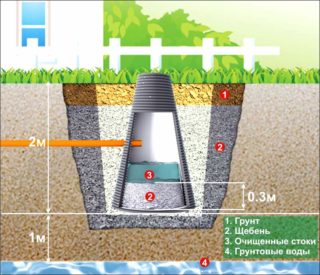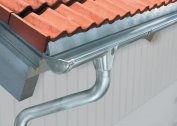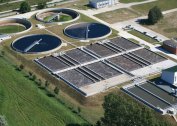The heterogeneous soil structure retains water in the area. This leads to devastating consequences, to prevent which a drainage well is used. This is the name of the design designed for the timely removal of moisture. It is especially in demand in areas with clay soil that impedes the natural outflow of fluid.
Definition and purpose of a drainage well
![]() Each of the soil rocks has certain parameters of water resistance. If the sand is low, the clay retains water in the upper layers for a long time. It gets there with spring flood, precipitation and as a result of rising groundwater. The result is flooding of cellars and basements. When frozen, moisture expands, destroying the foundation.
Each of the soil rocks has certain parameters of water resistance. If the sand is low, the clay retains water in the upper layers for a long time. It gets there with spring flood, precipitation and as a result of rising groundwater. The result is flooding of cellars and basements. When frozen, moisture expands, destroying the foundation.
The way out of the situation is the drilling of drainage wells. This is one of the simplest methods that has managed to prove effectiveness. It provides quick and regular drainage from the site, regardless of the time of year. Several holes are made in the ground, cutting through the water-resistant layers. Through them, moisture goes to tanks located at great depths.
The size of the wells depends on the thickness of the clay layer, usually it does not exceed 4 meters, but sometimes 10-meter holes have to be drilled.
Drilling causes both compaction and loosening of the soil. Because of this work, in no case do not produce near the foundation. In the worst case, moisture will pass through the walls of the pit, provoking suffusion - the removal of soil particles to the surface. This destroys the soil, leading to shrinkage of the foundation. To save him, the owner will be forced to raise the level of groundwater. To avoid this, you need to use the services of professionals.
Principle of operation
Water is lowered by one or more wells. They are drilled in a certain sequence, passing through a water-resistant layer. A pipe with holes made in advance is placed inside, where crushed stone (expanded clay) is filled. Through it, the liquid leaves the site and goes down.
In all cases, the depth of the holes should be below the level of the foundation and freezing of the soil, excluding the destruction and flooding of the lower tiers of the house. Crushed stone or expanded clay is poured so that the walls do not collapse, narrowing the diameter. If there is a pipe, these materials are poured inward for filtration, and many holes are made throughout the structure. The top is covered with a lid and sprinkled with earth.
Initially, a drainage well at high groundwater is made in the form of a trial version to identify the soil layers, determining the desired depth. The procedure is performed on their own or with the assistance of specialists.
Drainage device
 The structure of the well depends on the type selected. The drainage mechanism may be:
The structure of the well depends on the type selected. The drainage mechanism may be:
- Horizontal. A trench with several gutters connected.
- Upright. A well with or without a pump.
- Combined. The trench is connected with several wells.
- Cumulative. The collected moisture is subsequently used for irrigation.
In any case, the arrangement is carried out at a distance from the buildings. All of these structures quickly drain the territory. If the hole is drilled to a shallow depth, it needs to be made wider. Crushed stone, expanded clay or concrete chips are necessarily placed at the bottom. They strengthen drainage, while playing the role of a filter.
All methods are effective, but in each case, the water from the tanks is removed in different ways. Horizontal wells provide for its independent withdrawal from the site. In vertical structures, the process is carried out using a pump.Forced pumping is associated with seasonal events when the tanks are full.
The pump creates a suction force that changes the shape of the water, turning it into a funnel, the diameter and depth of which increases or decreases as it is pumped out. With the expanded structure of the wells, the pumps are interconnected, forming a single drainage space.
Well layout
Each hole forms a hydroconus with opening angles of 45 ° vertically. Based on this, a layout of the wells is compiled. Their number and parameters also depend on the following factors:
- landscape features;
- soil structure;
- average rainfall;
- groundwater location level.
 Drainage wells for drainage are preliminarily worked out in the form of a schematic design, only after this is the phase of direct production. The diagram always indicates:
Drainage wells for drainage are preliminarily worked out in the form of a schematic design, only after this is the phase of direct production. The diagram always indicates:
- depth and marking of elements located on the surface;
- the slope and direction of individual wells or channels, the interval between them;
- dimensions of all system components;
- list of materials.
The main thing is to correctly calculate the soil layer that needs to be cut, as well as determine the number and order of holes. In the absence of experience, the help of specialists will be useful.
Forced pumping of water leads to dangerous phenomena, when voids form under the ground, and it falls off. If the work is carried out on a large area, the project must take into account shifts, and the soil is specially compacted.
Wells of the self-flowing type are cheaper due to the lack of a pump. Often they are installed as a backup option, in case the main drainage can not cope. In large areas, several types of holes are used. It is important that auxiliary wells work periodically, otherwise later they will have to use a special pump - airlift.
Work stages
 It is recommended to equip the drainage even before laying the house foundation, evenly distributing the system throughout the site. The procedure is performed in several stages:
It is recommended to equip the drainage even before laying the house foundation, evenly distributing the system throughout the site. The procedure is performed in several stages:
- Creating a scheme, preparing tools and materials.
- Drilling 10-15 cm in diameter, 2-4 meters deep.
- Insert a specialized pipe with pre-made holes.
- Filling the pipe with washed gravel, expanded clay.
- Install cover or cover with waterproof material and backfill.
Drainage of the site using drainage wells is carried out constantly, but for this technology must be followed.
The cost of drilling a drainage well
The final decision is made by the owner of the site. The price per meter of drilling drainage wells for drainage depends on the characteristics of the soil, the nature and duration of the work. On average, the cost starts from 1500 rubles. It is advisable to resort to the services of professionals when it comes to a large territory where it is difficult to cope independently. In addition, it will save time and effort, eliminating errors and improvements.
The staff carefully inspects the house and other facilities at the facility. Their activities are regulated by standards and certificates, which ensures the safe operation of the drainage system. Proper service implies a long-term guarantee from the contractor.


